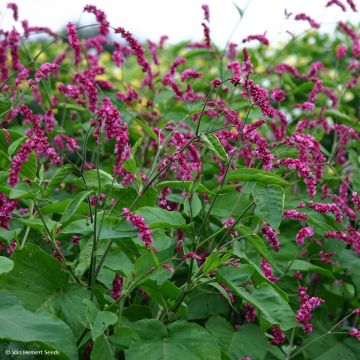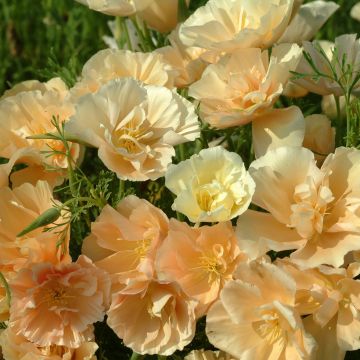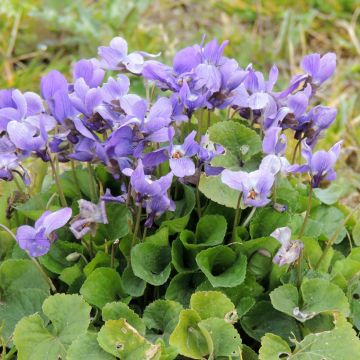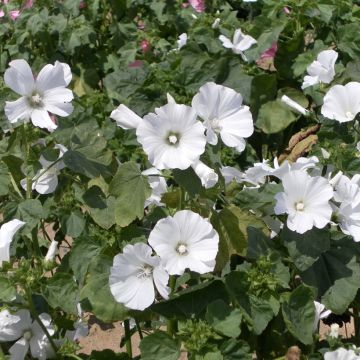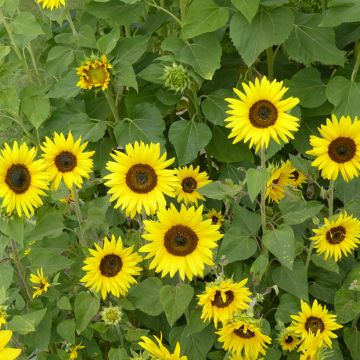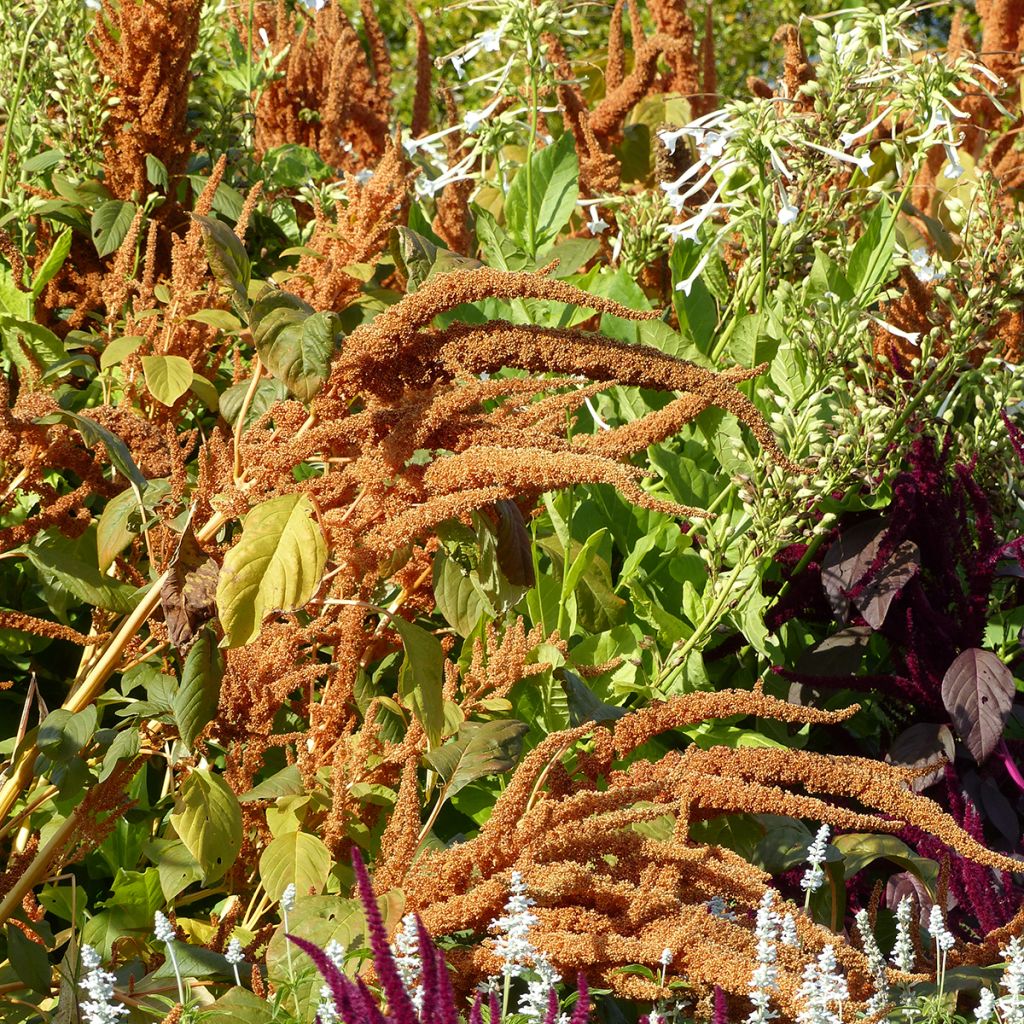

Graines d'amarante Hot Biscuits
Amaranthus hybridus subsp. cruentus Hot Biscuits
Amaranthus hybridus subsp. cruentus Hot Biscuits
Red Amaranth, Purple Amaranth, Prince's Feather, Showy Amaranth
This item cannot be shipped to the selected country
Dispatch by letter from €3.90
More information
Schedule delivery date,
and select date in basket
This plant carries a 6 months recovery warranty
More information
We guarantee the quality of our plants for a full growing cycle, and will replace at our expense any plant that fails to recover under normal climatic and planting conditions.
Seed-only orders are dispatched by sealed envelope. The delivery charge for seed-only orders is €3.90.
Does this plant fit my garden?
Set up your Plantfit profile →
Description
The Amaranthus cruentus, or Amarante Hot Biscuits, is a large tender plant most often cultivated as an annual in our climates. Spectacular, like all amaranths, this one displays large upright and slightly trailing panicles in a magnificent, slightly muted tawny colour. With rapid growth, it forms a beautiful display of leaves and flowers in long, uniquely textured spikes in just one season. This plant is magnificent in borders and bouquets, or in a pot where it can be overwintered frost-free. It can e grown by anyone: while it appreciates the sun, it thrives in any well-drained soil.
This bushy plant belongs to the Amaranthaceae family. It is native to western Asia (India, China, America). The 'Hot Biscuits' cultivar surprises with its animal-like, tawny colour. The plant forms vigorous, upright clumps that reach 1m (3ft) in height and 60cm (24in) in diameter. The large leaves, reaching 15cm (6in) in length, are elongated heart-shaped, tapering at their tips, and deeply veined. Frost-free, they persist through winter. Their colour is a purple with grey highlights, becoming more intense when the plant is exposed to the sun. They are alternate and arranged in a circle around the thick, sturdy stems. The remarkable flowering of this variety occurs from July to September-October.
Amaranths are wonderful colourful and structural plants that have their place in borders. Their exotic appearance also suits large pots on the patio. They are actually not very hardy perennials that can be overwintered frost-free. The 'Hot Biscuits' variety is magnificent alongside the silver foliage of wormwoods, the blue flowers of Centaurea or love-in-a-mist, the blonde spikes of grasses like squirrel tail barley. Its colour also pairs well with the metallic blue of some Eryngiums or blue oat grass (Helictotrichon sempervirens), as well as with certain Dahlias with equally astonishing colours.
Report an error about the product description
Flowering
Foliage
Plant habit
Botanical data
Amaranthus
hybridus subsp. cruentus
Hot Biscuits
Amaranthaceae
Red Amaranth, Purple Amaranth, Prince's Feather, Showy Amaranth
Cultivar or hybrid
Other Amaranthus seeds
Planting and care
Sow amaranth seeds in early spring at 21-24°C (69.8-75.2°F) in a good potting soil. Bury the seeds 2 mm (0.1 in) deep and keep the soil moist, but not waterlogged. It can be beneficial to enclose the sowing in a polythene bag. Germination usually takes 10 to 14 days. When the plants are large enough to handle, transplant them into pots or trays and acclimatise them to cooler conditions. Then gradually acclimate them to outdoor conditions for 10 to 15 days before planting them when the frosts have passed, spacing them 30-40 cm (12-16in) apart in a sunny location, in a good, deep, rich garden soil. These plants are quite water-demanding.
Sowing period
Intended location
This item has not been reviewed yet - be the first to leave a review about it.
Flower seeds
Haven't found what you were looking for?
Hardiness is the lowest winter temperature a plant can endure without suffering serious damage or even dying. However, hardiness is affected by location (a sheltered area, such as a patio), protection (winter cover) and soil type (hardiness is improved by well-drained soil).

Photo Sharing Terms & Conditions
In order to encourage gardeners to interact and share their experiences, Promesse de fleurs offers various media enabling content to be uploaded onto its Site - in particular via the ‘Photo sharing’ module.
The User agrees to refrain from:
- Posting any content that is illegal, prejudicial, insulting, racist, inciteful to hatred, revisionist, contrary to public decency, that infringes on privacy or on the privacy rights of third parties, in particular the publicity rights of persons and goods, intellectual property rights, or the right to privacy.
- Submitting content on behalf of a third party;
- Impersonate the identity of a third party and/or publish any personal information about a third party;
In general, the User undertakes to refrain from any unethical behaviour.
All Content (in particular text, comments, files, images, photos, videos, creative works, etc.), which may be subject to property or intellectual property rights, image or other private rights, shall remain the property of the User, subject to the limited rights granted by the terms of the licence granted by Promesse de fleurs as stated below. Users are at liberty to publish or not to publish such Content on the Site, notably via the ‘Photo Sharing’ facility, and accept that this Content shall be made public and freely accessible, notably on the Internet.
Users further acknowledge, undertake to have ,and guarantee that they hold all necessary rights and permissions to publish such material on the Site, in particular with regard to the legislation in force pertaining to any privacy, property, intellectual property, image, or contractual rights, or rights of any other nature. By publishing such Content on the Site, Users acknowledge accepting full liability as publishers of the Content within the meaning of the law, and grant Promesse de fleurs, free of charge, an inclusive, worldwide licence for the said Content for the entire duration of its publication, including all reproduction, representation, up/downloading, displaying, performing, transmission, and storage rights.
Users also grant permission for their name to be linked to the Content and accept that this link may not always be made available.
By engaging in posting material, Users consent to their Content becoming automatically accessible on the Internet, in particular on other sites and/or blogs and/or web pages of the Promesse de fleurs site, including in particular social pages and the Promesse de fleurs catalogue.
Users may secure the removal of entrusted content free of charge by issuing a simple request via our contact form.
The flowering period indicated on our website applies to countries and regions located in USDA zone 8 (France, the United Kingdom, Ireland, the Netherlands, etc.)
It will vary according to where you live:
- In zones 9 to 10 (Italy, Spain, Greece, etc.), flowering will occur about 2 to 4 weeks earlier.
- In zones 6 to 7 (Germany, Poland, Slovenia, and lower mountainous regions), flowering will be delayed by 2 to 3 weeks.
- In zone 5 (Central Europe, Scandinavia), blooming will be delayed by 3 to 5 weeks.
In temperate climates, pruning of spring-flowering shrubs (forsythia, spireas, etc.) should be done just after flowering.
Pruning of summer-flowering shrubs (Indian Lilac, Perovskia, etc.) can be done in winter or spring.
In cold regions as well as with frost-sensitive plants, avoid pruning too early when severe frosts may still occur.
The planting period indicated on our website applies to countries and regions located in USDA zone 8 (France, United Kingdom, Ireland, Netherlands).
It will vary according to where you live:
- In Mediterranean zones (Marseille, Madrid, Milan, etc.), autumn and winter are the best planting periods.
- In continental zones (Strasbourg, Munich, Vienna, etc.), delay planting by 2 to 3 weeks in spring and bring it forward by 2 to 4 weeks in autumn.
- In mountainous regions (the Alps, Pyrenees, Carpathians, etc.), it is best to plant in late spring (May-June) or late summer (August-September).
The harvesting period indicated on our website applies to countries and regions in USDA zone 8 (France, England, Ireland, the Netherlands).
In colder areas (Scandinavia, Poland, Austria...) fruit and vegetable harvests are likely to be delayed by 3-4 weeks.
In warmer areas (Italy, Spain, Greece, etc.), harvesting will probably take place earlier, depending on weather conditions.
The sowing periods indicated on our website apply to countries and regions within USDA Zone 8 (France, UK, Ireland, Netherlands).
In colder areas (Scandinavia, Poland, Austria...), delay any outdoor sowing by 3-4 weeks, or sow under glass.
In warmer climes (Italy, Spain, Greece, etc.), bring outdoor sowing forward by a few weeks.






































